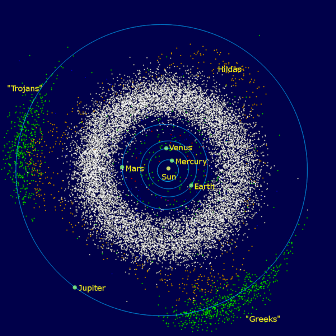One of these following facts about the asteroid belt will definitely provide you much information about the belt. Asteroid belt is the region of the Solar System located roughly between the orbits of the planets Mars and Jupiter. It is occupied by numerous irregularly shaped bodies called asteroids or minor planets. The asteroid belt is also termed the main asteroid belt or main belt to distinguish its members from other asteroids in the Solar System such as near-Earth asteroids and trojan asteroids. About half the mass of the belt is contained in the four largest asteroids, Ceres, Vesta, Pallas and Hygiea. They have mean diameters of more than 400 km, whereas Ceres, the asteroid belt’s only dwarf planet, is about 950 km in diameter. Furthermore, to get to know more about the belt, here are some other facts about the asteroid belt you might be interested in.
Facts about the asteroid belt 1: Common Birth
The process that helped form the planets is called accretion. During the beginning of the universe when two bodies would collide they would stick together forming a larger body. The planets and asteroids were formed in this manner. Obviously the planets accrued more mass than most of the asteroids. But, as seen by the asteroid Ceres being a dwarf planet, some asteroids came very close to garnering enough mass and generate gravity just enough to possible become planets in their own right.
Facts about the asteroid belt 2: Composition
Asteroids are made of different minerals and substances. Their composition depends on the planet they broke away from in a collision, as well as the chemical reactions they might have experienced while orbiting in the solar system. The asteroids nearest to the Sun are mostly carbonaceous while the ones further away are composed of silicate rock. The metallic asteroids are made of up to 80% iron with the rest being nickel with many other metals such as iridium, palladium, platinum, and gold mixed in.
Facts about the asteroid belt 3: Dust
Most asteroids are covered in dust. This dust is called regolith. It is a rocky rubble more that dust and is the result of constant collisions in space. These collision are between asteroids and any other body that crosses their path. The larger object wins and ends up covered in the rubble from the losing object. Sometimes space weathering has shown that some asteroids are OC meteorites that are covered in regolith.
Facts about the asteroid belt 4: Impact Events
Impact events shaped the asteroids. Nearly every object in space, including Earth, has been shaped in some way or another by impact events. Every heavenly body has at least two impact craters on its surface. These impact events can destroy an asteroid or cause tow asteroids to join together. The impact can cause changes in orbit, rotation, or axial tilt.
Facts about the asteroid belt 5: Spacecraft Galileo
The spacecraft Galileo proved that point in 1993 when it did a flyby of the asteroid 243 Ida and discovered its moon dactyl. That was the first object to be found to have a moon of its own that was not a planet. Several others have been discovered since, but the first was the most exciting for astronomy.
Facts about the asteroid belt 6: Evolution
The asteroids are not samples of the primordial Solar System. They have undergone considerable evolution since their formation, including internal heating (in the first few tens of millions of years), surface melting from impacts, space weathering from radiation, and bombardment by micrometeorites.
Facts about the asteroid belt 7: Characteristic
Contrary to popular imagery, the asteroid belt is mostly empty. The asteroids are spread over such a large volume that it would be improbable to reach an asteroid without aiming carefully. Nonetheless, hundreds of thousands of asteroids are currently known, and the total number ranges in the millions or more, depending on the lower size cutoff.
Facts about the asteroid belt 8: Main-belt Comets
Several otherwise unremarkable bodies in the outer belt show cometary activity. Because their orbits cannot be explained through capture of classical comets, it is thought that many of the outer asteroids may be icy, with the ice occasionally exposed to sublimation through small impacts.
Facts about the asteroid belt 9: Exploration
The first spacecraft to traverse the asteroid belt was Pioneer 10, which entered the region on July 16, 1972. At the time there was some concern that the debris in the belt would pose a hazard to the spacecraft, but it has since been safely traversed by 11 Earth-based craft without incident. Pioneer 11, Voyagers 1 and 2 and Ulysses passed through the belt without imaging any asteroids.
Facts about the asteroid belt 10: Datura Cluster
More recently, the Datura cluster appears to have formed about 450 thousand years ago from a collision with a main-belt asteroid. The age estimate is based on the probability of the members having their current orbits, rather than from any physical evidence. However, this cluster may have been a source for some zodiacal dust material.
Hope you would find those asteroid belt facts really interesting, useful and helpful for your additional reading.










 www.PortlandPayday.Loans
www.PortlandPayday.Loans